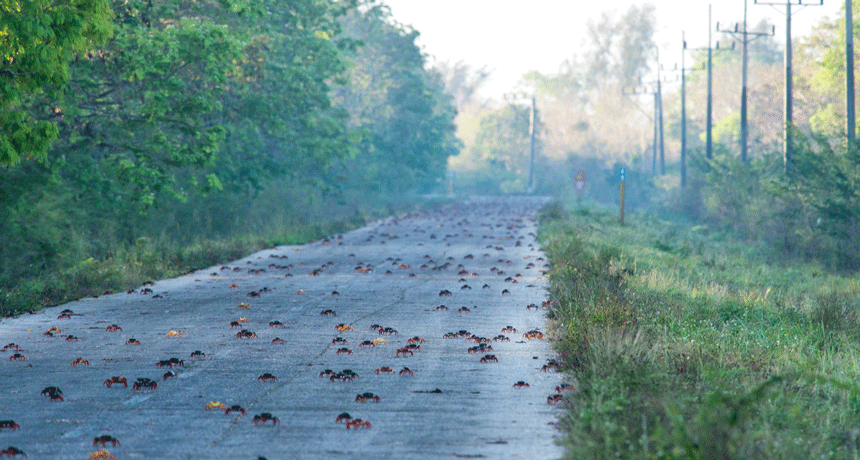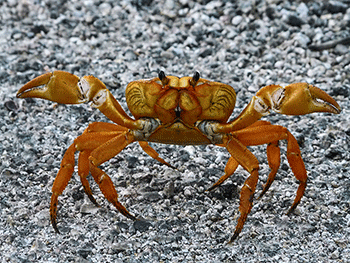Migrating crabs take their eggs to the sea
This yearly spectacle of marching crabs could help Cuba preserve a critical swamp and coast

Invasion! A highway along the Bay of Pigs is covered with skittering land crabs on their way to lay eggs in the sea.
Allan Hopkins
By Bryn Nelson
PLAYA LARGA, Cuba — When Cuba’s dry season ends and the spring rains start, strange creatures begin stirring within the soggy forests of Zapata Swamp. Rain here, along the country’s southern coast, means romance for land crabs. After they mate in underground burrows, the red, yellow and black females emerge by the millions. Then they scuttle toward the ocean to deposit their fertilized eggs in the water.
Some observers have compared the waves of skittering crabs to scenes from a horror movie. The bizarre mass migrations, though, form an important link in the coastal ecosystem here. The crabs, after all, are a welcome source of food for other animals, both on land and at sea.
So many of the ten-legged creatures appear at dawn and dusk that they can turn roads and beaches red. They also can puncture the car tires of unlucky drivers. A few weeks after the yearly invasion, broken bits of shell and crab legs still litter the main highway by Playa Larga. The crabmeat is toxic to people. But scientists are finding that other animals love it.

This crunchy land crab is sometimes on the menu of the critically endangered Cuban crocodile. Orestes Martínez García, a local bird watching guide and researcher, points out another important predator. Two Cuban black hawks have built a nest in a tree next to a coastal highway. Like the crocodile, the hawks are unique to this island country. A male stands guard on a branch while his female mate incubates eggs in the nest. It’s the perfect perch from which to swoop down and feast on the crabmeat. Even better, many of the flattened crabs have already been shelled.
Once they’ve carefully released their eggs into the ocean, mother crabs turn around and skitter back to the swamp. In the sea, a feeding frenzy now ensues. Mullet and other fish in the shallow reefs gorge on the tiny crabs that hatch from the eggs. The baby crabs that survive their first few weeks adrift will clamber out and join adults in the nearby forest. Eventually, some of them will make the same journey back to the ocean.
Despite being pounded into crab cakes by the thousands, Cuba’s population doesn’t seem to be in immediate danger. Officials close the highway and other streets to protect the crabs (and car tires!) during peak crossing times.
Even so, scientists warn that building too many homes and businesses nearby could reduce the crabs’ habitat. Hotels or other barriers could prevent the adults from reaching the ocean or keep their babies from returning home. Scientists have documented this threat on other Caribbean islands. They warn that more development also could increase the harmful pollution flowing into the swamp and ocean.
Some tourists come to see the odd spectacle of the crabs’ march to the sea. Others come to view the local crocodiles, birds and corals. These visitors have been good for Playa Larga, Martínez García says. The popular attractions mean that area residents have incentives to help preserve the swamp and sea around them. In doing so, they may help ensure that the weird and wondrous land crabs will feed other creatures far into the future.







